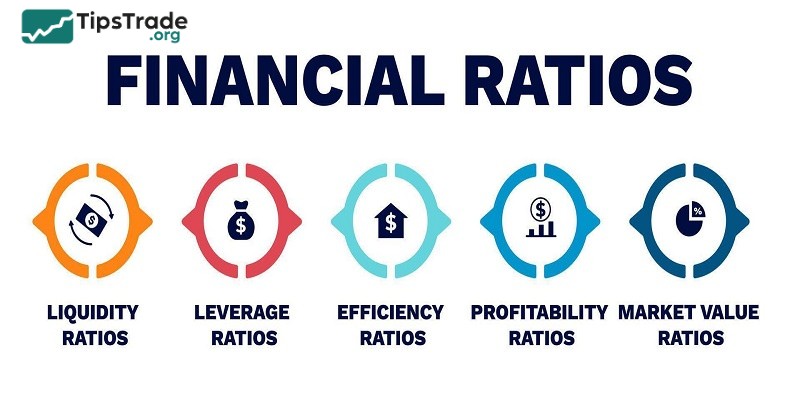Mastering financial ratios is a prerequisite for investors to make sound decisions. These ratios not only provide an overview of a company’s financial situation but also help assess investment potential and risk levels. Below are 5 key types of financial ratios that you should not overlook.
What are financial ratios?
Financial ratios are basic calculations that use quantitative data from a company’s financial statements. They are used to provide important insights and information about a company’s performance, profitability, and financial position.
Common financial ratios are derived from a company’s balance sheet, income statement, and cash flow statement.
Businesses use financial ratios to determine liquidity, debt concentration, growth rate, profitability, and market value.

Why should you care about financial ratios?
Financial ratios are the “secret weapon” that helps you uncover valuable insights into your business’s financial performance, beyond what your standard financial statements can show. They also help you compare your performance with similar businesses in your industry.
While balance sheets, income statements, and cash flow statements provide useful information, they only scratch the surface. Financial ratios, on the other hand, go deeper into the core of your business’s finances, showing how well you’re managing your capital, generating profits, driving sales, and controlling costs. They can also act as an early warning system, letting you know when changes are needed to improve your situation.
Types of financial ratios
Financial ratios are grouped into the following categories:
- Liquidity Ratios
- Leverage Ratios
- Efficiency Ratios
- Profitability Ratios
- Market Value Ratios

Liquidity ratios
Liquidity ratios are financial ratios used to measure a company’s ability to pay both short-term and long-term obligations. Common liquidity ratios include:
- Current Ratio: Measures a company’s ability to pay short-term debts with short-term assets.
Current Ratio = Current Assets / Current Liabilities
- Acid-Test Ratio: Measures a company’s ability to pay short-term debts with its liquid assets (excluding inventories).
Acid-Test Ratio = Current Assets – Inventories / Current Liabilities
- Cash Ratio: Measures a company’s ability to pay short-term debts with cash and cash equivalents.
Cash Ratio = Cash and Cash Equivalents / Current Liabilities
- Operating Cash Flow Ratio: Measures how many times a company can pay off short-term debt with cash flow generated from operations in a given period.
Operating Cash Flow Ratio = Operating Cash Flow / Current Liabilities
Leverage financial ratios
Leverage ratios measure the extent to which a company’s capital comes from debt. In other words, financial leverage ratios are used to assess a company’s level of debt. Common leverage ratios include:
- Debt Ratio: Measures the proportion of a company’s assets that are financed by debt.
Debt Ratio = Total Liabilities / Total Assets
- Debt to Equity Ratio: Calculates the burden of total debt and financial obligations relative to owners’ equity.
Debt to Equity Ratio = Total Liabilities / Shareholders’ Equity
- Interest Coverage Ratio: Shows how easily a company can cover its interest expenses.
Interest Coverage Ratio = Operating Income / Interest Expenses
- Debt Service Coverage Ratio: Reflects how easily a company can meet its debt obligations.
Debt Service Coverage Ratio = Operating Income / Total Debt Service
Efficiency ratios
Efficiency ratios, also known as activity financial ratios, are used to measure how well a company is utilizing its assets and resources. Common efficiency ratios include:
- Asset turnover ratio: Measures a company’s ability to generate sales from assets.
Asset Turnover Ratio = Net Sales / Average Total Assets
- Inventory turnover ratio: Measures how many times a company’s inventory is sold and replaced over a given period.
Inventory Turnover Ratio = Cost of Goods Sold / Average Inventory
- Receivable turnover ratio: Measures how many times a company can turn receivables into cash over a given period.
Receivables Turnover Ratio = Net Credit Sales / Average Accounts Receivable
- Days sales in inventory ratio: Measures the average number of days that a company holds on to inventory before selling it to customers.
Days Sales in Inventory Ratio = 365 Days / Inventory Turnover Ratio
Profitability ratios
Profitability ratios measure a company’s ability to generate income relative to revenue, balance sheet assets, operating costs, and equity. Common profitability financial ratios include the following:
- Gross margin ratio: Compares the gross profit of a company to its net sales to show how much profit a company makes after paying its cost of goods sold.
Gross Margin Ratio = Gross Profit / Net Sales
- Operating margin ratio: Sometimes known as the return on sales ratio, compares the operating income of a company to its net sales to determine operating efficiency.
Operating Margin Ratio = Operating Income / Net Sales
- Return on assets ratio: Measures how efficiently a company is using its assets to generate profit.
Return on Assets Ratio = Net Income / Total Assets
- Return on equity ratio: Measures how efficiently a company is using its equity to generate profit.
Return on Equity Ratio = Net Income / Shareholders’ Equity
Market value ratios
Market value ratios are used to evaluate the share price of a company’s stock. Common market value ratios include the following:
- Book value per share ratio: Calculates the per-share value of a company based on the equity available to shareholders.
Book Value Per Share Ratio = (Shareholder’s Equity – Preferred Equity) / Total Common Shares Outstanding
- Dividend yield ratio: Measures the amount of dividends attributed to shareholders relative to the market value per share:
Dividend Yield Ratio = Dividend per Share / Share Price
- Earnings per share ratio: Measures the amount of net income earned for each share outstanding:
Earnings Per Share Ratio = Net Earnings / Total Shares Outstanding
- Price-earnings ratio: Compares a company’s share price to its earnings per share:
Price-Earnings Ratio = Share Price / Earnings Per Share
Benefits and limitations of financial ratios
Below are the benefits and limitations of Financial Ratios:
Benefits of financial ratios
- Point out areas for improvement: Suppose a company has a lower asset turnover ratio than its competitors. This indicates that the company needs to either reduce assets or increase sales. This can be done by increasing spending on business development activities or by utilizing excess capacity to build a strategy for the future.
- Planning: If a company’s debt ratio increases over time, it signals the need for the company to reduce debt or find other sources of funding as its assets may not be sufficient to cover future debts. Therefore, the ratios act as a tool to control overspending or debt accumulation.
- Define limits: Each organization or industry sets ideal levels for certain metrics. This helps companies check whether their metrics are within regulatory limits and closely monitor risky or undesirable activities.
- Popular: Metrics are popular analytical tools and are calculated regularly by most companies both internally and externally.

Limitations of financial ratios
- Differences in calculation: Each issuer may calculate ratios differently and analyze information from financial statements and notes differently. Sometimes they include some figures but exclude others. As a result, there is little consistency between issuers, making comparisons difficult.
- Depending on accounting standards: Accounting principles can distort some metrics that are not measured by cash flow. For example, using the residual value method of depreciation will inflate the value of assets, thereby showing the company’s ability to pay its bills better than it really is.
Conclusion
Here are the key types of financial ratios that investors need to clearly understand in order to accurately assess the operational situation before making investment decisions. Reading and thoroughly recognizing the meanings of these ratios requires investors to study in-depth and frequently practice applying them in specific cases to accumulate experience for themselves in trading. Wishing you all success!

